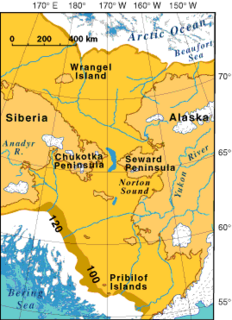 W
WThe settlement of the Americas is widely accepted to have begun when Paleolithic hunter-gatherers entered North America from the North Asian Mammoth steppe via the Beringia land bridge, which had formed between northeastern Siberia and western Alaska due to the lowering of sea level during the Last Glacial Maximum. These populations expanded south of the Laurentide Ice Sheet and spread rapidly throughout both North and South America, by 14,000 years ago. The earliest populations in the Americas, before roughly 10,000 years ago, are known as Paleo-Indians.
 W
WThe settlement of the Americas is widely accepted to have begun when Paleolithic hunter-gatherers entered North America from the North Asian Mammoth steppe via the Beringia land bridge, which had formed between northeastern Siberia and western Alaska due to the lowering of sea level during the Last Glacial Maximum. These populations expanded south of the Laurentide Ice Sheet and spread rapidly throughout both North and South America, by 14,000 years ago. The earliest populations in the Americas, before roughly 10,000 years ago, are known as Paleo-Indians.
 W
WThe Ancient Beringians (AB) is a specific archaeogenetic lineage, based on the genome of an infant found at the Upward Sun River site, dated to 11,500 years ago. The AB lineage diverged from the Ancestral Native American (ANA) lineage about 20,000 years ago. The ANA lineage was estimated as having been formed between 20,000 and 25,000 years ago by a mixture of East Asian and Ancient North Eurasian lineages, consistent with the model of the peopling of the Americas via Beringia during the Last Glacial Maximum.
 W
WThe Clovis culture is a prehistoric Paleoamerican culture, named for distinct stone tools found in close association with Pleistocene fauna at Blackwater Locality No. 1 near Clovis, New Mexico in the 1920s and 1930s. It appears around 11,500–11,000 uncalibrated RCYBP at the end of the last glacial period, and is characterized by the manufacture of "Clovis points" and distinctive bone and ivory tools. Archaeologists' most precise determinations at present suggest this radiocarbon age is equal to roughly 13,200 to 12,900 calendar years ago. Clovis people are considered to be the ancestors of most of the indigenous peoples of the Americas.
 W
WLuzia Woman is the name for an Upper Paleolithic period skeleton of a Paleo-Indian woman who was found in a cave in Brazil. Some archaeologists originally thought the young woman may have been part of a migratory wave of immigrants prior to the ancestors of today's Amerindians, though DNA and other evidence has shown this to be improbable. The 11,500-year-old skeleton was found in a cave in the Lapa Vermelha archeological site in Pedro Leopoldo, in the Greater Belo Horizonte region of Brazil, in 1974 by archaeologist Annette Laming-Emperaire. The nickname Luzia was chosen in homage to the Australopithecus fossil Lucy. The fossil was kept at the National Museum of Brazil, where it was shown to the public until it was fragmented during a fire that destroyed the museum on September 2, 2018. On October 19, 2018, it was announced that most of Luzia's remains were identified from the Museu Nacional debris, which allowed them to rebuild part of her skeleton.
 W
WPedra Furada is an important collection of over 800 archaeological sites in the state of Piauí, Brazil. These include hundreds of rock paintings dating from circa 12,000 years before present. More importantly, charcoal from very ancient fires and stone shards that may be interpreted as tools found at the location were dated from 48,000 to 32,000 years before present, suggesting the possibility of a human presence tens of thousand of years prior to the arrival of the Clovis people in North America.
 W
WThe Solutrean hypothesis on the peopling of the Americas claims that the earliest human migration to the Americas took place from Europe, during the Last Glacial Maximum. This hypothesis contrasts with the mainstream view that the North American continent was first reached after the Last Glacial Maximum, by people from North Asia, either by the Bering land bridge, or by maritime travel along the Pacific coast, or by both.